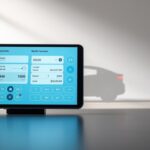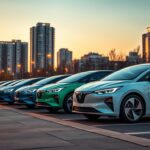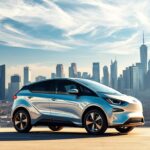
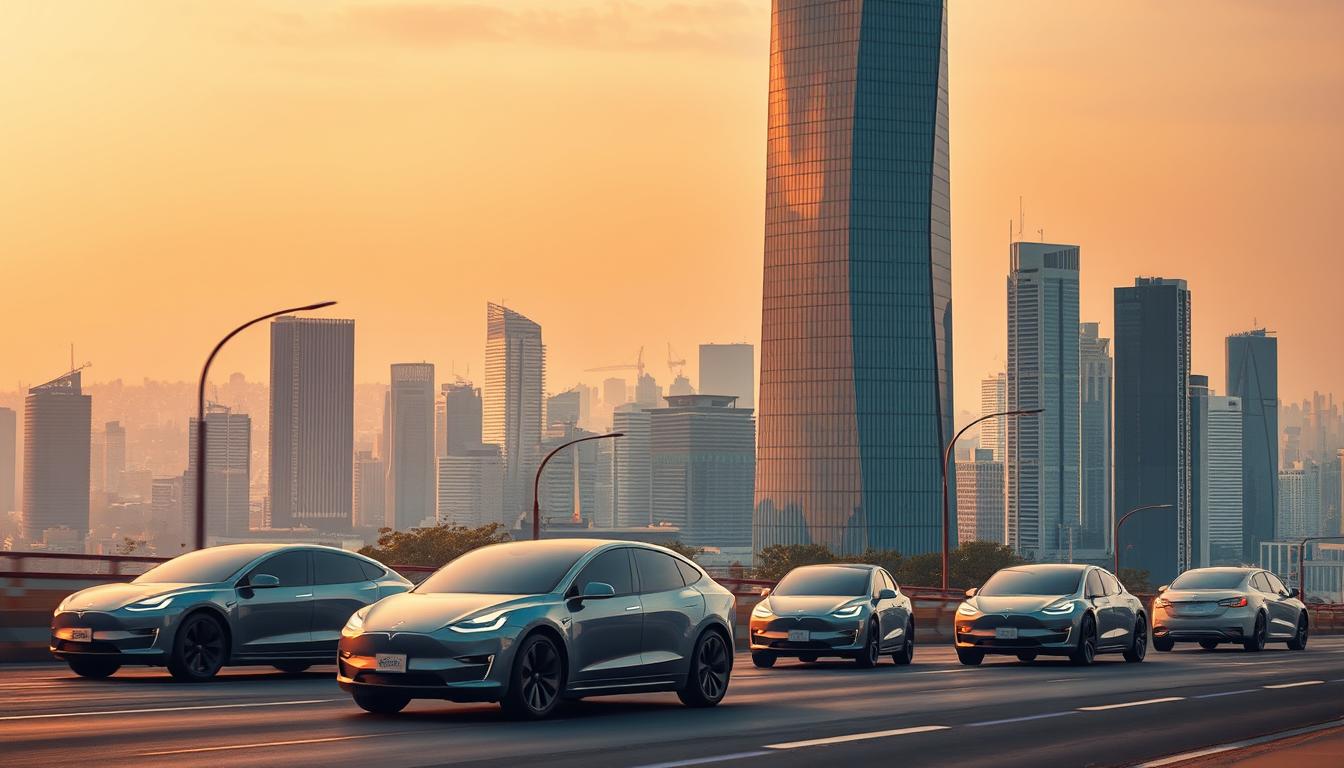
Robot Tesla
The innovative Autonomous Electric Vehicles are changing the way we travel. At the forefront of this revolution is the Tesla Autopilot technology, enabling vehicles to navigate through complex environments with ease.
With its cutting-edge robotics and autonomous features, the Robot Tesla is poised to transform the transportation industry. As we move towards a more sustainable future, the significance of such vehicles cannot be overstated.
Key Takeaways
- Robot Tesla combines cutting-edge robotics and autonomous features.
- The vehicle is revolutionizing the future of transportation.
- Tesla Autopilot technology enables complex navigation.
- Autonomous Electric Vehicles are changing the way we travel.
- The significance of Robot Tesla lies in its potential to transform the industry.
The Genesis of Tesla’s Autonomous Vision
Elon Musk’s ambitions in robotics laid the groundwork for Tesla’s autonomous future. The journey towards creating vehicles that can operate without human intervention began with a clear vision for the future of transportation.
Elon Musk’s Early Robotics Ambitions
Elon Musk has long been fascinated by the potential of robotics and artificial intelligence to transform industries. His early endeavors in this space were driven by a desire to push the boundaries of what was thought possible. Tesla’s foray into autonomous technology was a natural progression of Musk’s interests, leveraging advancements in AI and robotics to create smarter vehicles.
From Driver Assistance to Full Self-Driving
Tesla’s autonomous technology evolved significantly from its initial driver assistance features. The company progressed from developing Autopilot capabilities, which assist drivers with steering and braking, to more sophisticated Full Self-Driving (FSD) technology. This progression represents a significant leap towards achieving true autonomy.
| Feature | Description | Release Status |
|---|---|---|
| Autopilot | Assists with steering, braking, and acceleration | Released |
| Full Self-Driving (FSD) | Enables vehicles to operate without human input | In Development |
| Enhanced Autopilot | Intermediate features between Autopilot and FSD | Released |
Tesla continues to refine its autonomous technology, with ongoing updates aimed at enhancing the capabilities of its vehicles. The company’s commitment to achieving full self-driving is evident in its over-the-air updates, which allow for continuous improvement without the need for physical visits to service centers.
Understanding Robot Tesla Technology
At the heart of Tesla’s innovation lies a complex interplay of hardware and software that enables its Robot technology. This synergy is what allows Tesla’s vehicles to navigate complex environments with ease.
Hardware Foundation
The hardware that powers Tesla’s Full Self-Driving (FSD) capabilities is a critical component of its Robot technology. This includes the FSD Computer Architecture, designed to process vast amounts of data from various sensors.
FSD Computer Architecture
Tesla’s FSD computer is a marvel of modern engineering, capable of processing complex algorithms at incredible speeds. As Elon Musk noted, “The FSD computer is a significant step forward in autonomous driving technology.”
Sensor Arrays and Integration
The sensor arrays used in Tesla’s vehicles are comprehensive, including cameras, radar, and ultrasonic sensors. These sensors work in tandem to provide a 360-degree view of the environment, enabling the vehicle to make informed decisions.
Software Intelligence Systems
The software that powers Tesla’s Robot technology is equally impressive, relying on advanced Neural Networks and deep learning algorithms to interpret data from the hardware.
Neural Networks and Deep Learning
Tesla’s use of neural networks allows its vehicles to learn from vast amounts of data, improving their ability to navigate complex scenarios. “Neural networks are a crucial component of our autonomous driving technology,” as emphasized by Tesla’s engineers.
Decision-Making Algorithms
The decision-making algorithms used by Tesla’s software are designed to be highly sophisticated, enabling vehicles to react to a wide range of situations. These algorithms are continually updated through over-the-air updates, ensuring that Tesla’s Robot technology remains at the forefront of innovation.
Core Features of Robot Tesla
At the core of Robot Tesla lies a suite of advanced Autopilot features that enhance safety and convenience. These features are designed to make autonomous driving a reality, providing drivers with a more relaxed and enjoyable driving experience.
Autopilot Capabilities
Tesla’s Autopilot technology is a cornerstone of its Robot Tesla innovation. It includes several advanced features that assist drivers in various driving scenarios.
Highway Navigation and Lane Keeping
The Highway Navigation and Lane Keeping feature allows Robot Tesla to stay within its lane and navigate highways with ease. This is achieved through a combination of cameras and sensors that monitor the vehicle’s surroundings.
Traffic-Aware Cruise Control
Traffic-Aware Cruise Control is another key feature that adjusts the vehicle’s speed based on traffic conditions. This ensures a smooth and safe driving experience, even in heavy traffic.
Full Self-Driving Features
Tesla is also working towards Full Self-Driving (FSD) capabilities that will enable Robot Tesla to drive autonomously in most situations. FSD includes features like Navigate on Autopilot and Smart Summon.
Navigate on Autopilot
Navigate on Autopilot allows the vehicle to automatically change lanes, navigate interchanges, and take exits. This feature represents a significant step towards achieving full autonomy.
Smart Summon and Auto Park
The Smart Summon feature allows drivers to call their vehicle to them using the Tesla app. Auto Park enables the vehicle to park itself, making parking easier and more convenient.
The combination of these Autopilot and Full Self-Driving features positions Robot Tesla at the forefront of autonomous vehicle technology, offering a glimpse into the future of transportation.
The Tesla Bot: Expanding the Robot Tesla Ecosystem
The Tesla Bot, also known as Optimus, represents a significant leap in robotics and AI technology. This humanoid robot is designed to perform a variety of tasks, making it a valuable addition to the Robot Tesla ecosystem.
Optimus Humanoid Robot Specifications
The Optimus robot is engineered with advanced hardware and software capabilities. It stands at an impressive height and is designed to navigate and interact with its environment with ease. The robot’s articulated arms and dexterous hands enable it to perform complex tasks that require precision and flexibility.
Key specifications include:
- Advanced AI processing unit
- High-resolution sensors for enhanced perception
- Long-lasting battery life
Integration with Tesla Vehicle Technology
One of the most exciting aspects of the Tesla Bot is its integration with Tesla’s vehicle technology. This synergy allows for a seamless interaction between the robot and Tesla vehicles, enhancing the overall user experience. The robot can be controlled via the Tesla mobile app, and it can also receive software updates over-the-air, just like Tesla cars.
The integration enables features such as:
- Synchronized navigation between the robot and Tesla vehicles
- Shared AI insights for improved performance
- Unified user interface across Tesla products
User Experience and Interface Design
With Robot Tesla, the future of driving is not just about autonomy, but also about an enhanced user experience. Tesla has focused on creating an intuitive and engaging interface that makes interacting with the vehicle seamless.
Touchscreen Controls and Voice Commands
The touchscreen controls in Tesla vehicles are designed to be intuitive, allowing drivers to easily access various features and settings. Coupled with voice commands, the interface becomes even more user-friendly, enabling drivers to keep their hands on the wheel and eyes on the road.
Tesla Mobile App Integration
The Tesla Mobile App extends the user experience beyond the vehicle, allowing owners to monitor and control their cars remotely. From checking the vehicle’s status to controlling the climate, the app provides a comprehensive interface for Tesla owners.
| Feature | Description | Benefit |
|---|---|---|
| Touchscreen Controls | Intuitive interface for vehicle settings | Easy access to features |
| Voice Commands | Hands-free control for safety | Enhanced safety and convenience |
| Tesla Mobile App | Remote monitoring and control | Greater control and flexibility |
By integrating user experience into every aspect of Robot Tesla, Tesla continues to push the boundaries of what is possible in autonomous driving.
Safety Systems and Redundancy
At the heart of Robot Tesla lies a comprehensive safety architecture that includes collision avoidance and driver monitoring. This multi-layered approach ensures that Robot Tesla provides a secure driving experience.
Collision Avoidance Technology
Robot Tesla is equipped with advanced collision avoidance technology, utilizing a combination of cameras, radar, and ultrasonic sensors to detect potential hazards. This system enables the vehicle to take corrective action, such as automatic emergency braking, to prevent or mitigate collisions.
Key Features: Automatic emergency braking, lane departure warning, and blind-spot detection.
Driver Monitoring Systems
The driver monitoring system in Robot Tesla uses a combination of camera-based monitoring and sensor data to ensure the driver is attentive and ready to take control of the vehicle when necessary. This system can detect signs of driver fatigue or distraction, alerting the driver to take corrective action.
Fail-Safe Mechanisms
Robot Tesla incorporates multiple fail-safe mechanisms to ensure continued safe operation in the event of a system failure. These mechanisms include redundant systems for critical functions, such as steering and braking, to provide an additional layer of safety.
| Safety Feature | Description | Benefit |
|---|---|---|
| Collision Avoidance | Uses cameras, radar, and ultrasonic sensors to detect hazards. | Reduces risk of collisions. |
| Driver Monitoring | Monitors driver attention and alerts for fatigue or distraction. | Enhances driver safety and awareness. |
| Fail-Safe Mechanisms | Provides redundant systems for critical functions. | Ensures continued safe operation. |
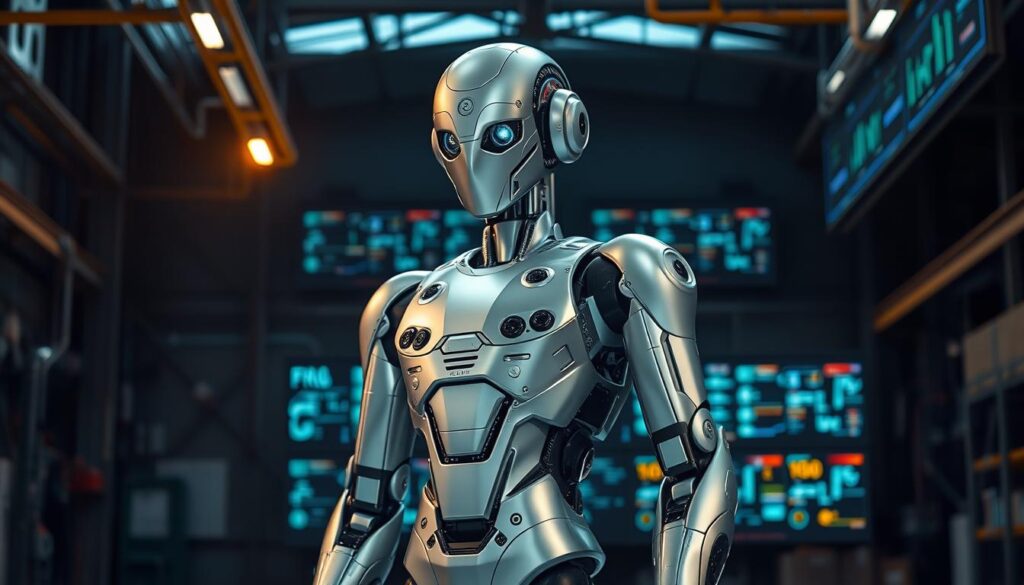
Over-the-Air Updates: The Evolving Robot Tesla
The future of autonomous driving is being shaped by Tesla’s over-the-air updates, which enable the company to continually improve and expand the capabilities of its vehicles. This technology allows Tesla to address issues, add new features, and enhance performance without the need for physical visits to service centers.
Software Version History
Tesla’s software version history is a testament to the company’s commitment to innovation. With each new update, Tesla builds upon the previous version, refining and expanding the features of its Autopilot and Full Self-Driving (FSD) capabilities. For instance, updates have introduced improvements such as enhanced navigation, better object detection, and more sophisticated decision-making algorithms.
How Updates Enhance Capabilities
Over-the-air updates significantly enhance Tesla’s Robot capabilities by introducing new features and improving existing ones. For example, updates have enabled Tesla vehicles to perform complex maneuvers like automatic lane changes and highway exits. Moreover, these updates have improved the overall safety and reliability of Tesla’s Autopilot system, making it more adept at handling various driving scenarios.
By continually updating its software, Tesla ensures that its vehicles remain at the forefront of autonomous driving technology, providing owners with a constantly improving driving experience.
Regulatory Challenges and Legal Framework
As Robot Tesla continues to revolutionize the automotive industry, it faces a complex web of regulatory challenges. The legal framework governing autonomous vehicles is still in its nascent stages, and Tesla must navigate this evolving landscape to ensure compliance.
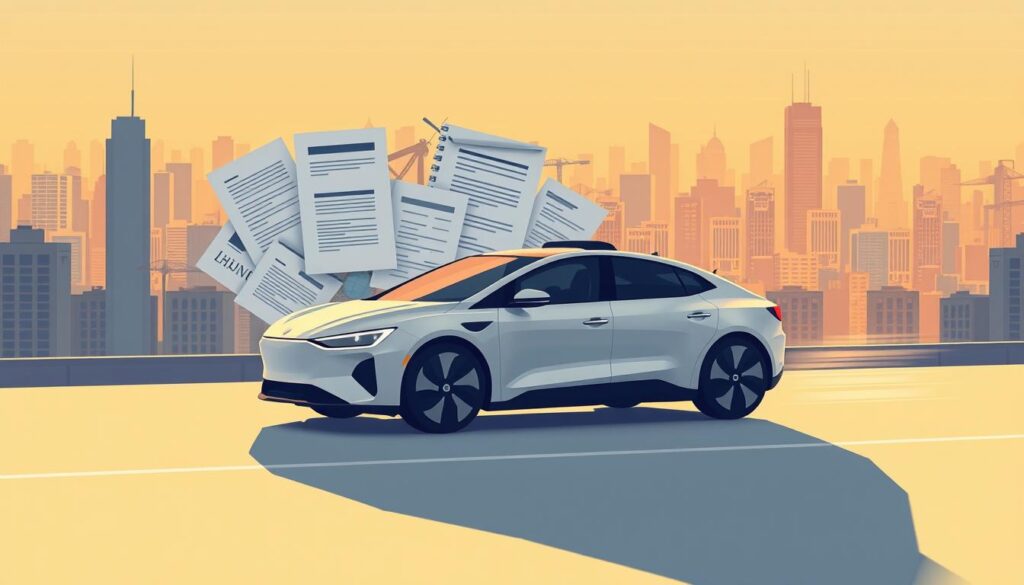
Current Autonomous Vehicle Legislation
The current legislative framework for autonomous vehicles varies significantly across different states in the U.S. Some states have enacted specific laws to govern the testing and deployment of autonomous vehicles, while others are still in the process of drafting legislation. For instance, states like California and Nevada have established clear guidelines for the testing of autonomous vehicles, including requirements for public disclosure and safety protocols.
At the federal level, there is an ongoing effort to create a unified regulatory framework. The National Highway Traffic Safety Administration (NHTSA) has issued guidelines aimed at ensuring the safe deployment of autonomous vehicles. These guidelines emphasize the need for robust safety standards and cybersecurity measures.
Tesla’s Approach to Compliance
Tesla has been proactive in complying with existing regulatory requirements. The company works closely with state and federal authorities to ensure that its autonomous driving technology meets all necessary safety and operational standards. Tesla’s approach includes regular software updates that not only enhance the performance of its vehicles but also ensure ongoing compliance with evolving regulatory standards.
By engaging with regulators and participating in the legislative process, Tesla plays a crucial role in shaping the future regulatory landscape for autonomous vehicles. This collaborative approach helps to address the regulatory challenges associated with Robot Tesla and paves the way for the wider adoption of autonomous driving technology.
Market Competition and Tesla’s Position
With its advanced Autopilot technology, Tesla is well-positioned in the competitive autonomous vehicle market. The landscape is rapidly evolving, with various players vying for dominance.
The autonomous vehicle industry is witnessing significant investments from both traditional automakers and tech companies. Tesla’s early mover advantage has given it a unique position, but competitors are catching up.
Traditional Automakers’ Autonomous Efforts
Traditional automakers are heavily investing in autonomous technology. For instance:
- General Motors is developing its Super Cruise technology.
- Volkswagen is partnering with Argo AI to enhance its autonomous capabilities.
- Ford is investing in self-driving technology through its subsidiary, Ford Autonomous Vehicles.
These efforts indicate a significant shift towards autonomy in the traditional automotive sector.
Tech Companies in the Autonomous Space
Tech companies are also making substantial inroads into the autonomous vehicle market:
- Waymo, a subsidiary of Alphabet, is a leading player with its advanced driver-assistance systems.
- Amazon is rumored to be developing its autonomous delivery vehicles.
- Uber has been testing autonomous vehicles, although it has faced regulatory challenges.
Tesla’s position in this competitive landscape is bolstered by its over-the-air update capabilities and a strong brand loyalty. As the autonomous market continues to evolve, Tesla’s ability to innovate and adapt will be crucial.
The Future Roadmap for Robot Tesla Technology
Tesla’s vision for the future of Robot Tesla technology is not just about enhancing autonomy but transforming the entire driving experience. As the company continues to innovate, the roadmap for Robot Tesla is filled with exciting developments that promise to revolutionize the automotive industry.
Upcoming Features and Capabilities
The upcoming features for Robot Tesla include advanced navigation systems, enhanced object detection, and improved decision-making algorithms. These advancements will enable Tesla vehicles to handle complex driving scenarios with ease, making autonomous driving more accessible and reliable.
Key Features on the Horizon:
- Enhanced Autopilot capabilities
- Advanced driver monitoring systems
- Improved over-the-air update technology
As Elon Musk once said,
“The future is going to be a lot more autonomous, and I think that’s going to be a great thing.”
This quote encapsulates Tesla’s commitment to pushing the boundaries of autonomous technology.
Tesla’s Long-Term Autonomous Vision
Tesla’s long-term vision for autonomy extends beyond just vehicles; it encompasses a future where robots and vehicles communicate seamlessly, creating a network of intelligent machines that can assist humans in various capacities.
The potential applications are vast, from enhancing road safety to providing personal assistance. Tesla’s commitment to this vision is evident in its continuous investment in AI and autonomous technology.
As Tesla continues to innovate, the future of Robot Tesla technology looks promising, with the potential to transform not just the automotive industry but society as a whole.
Conclusion
Tesla’s foray into autonomous technology with Robot Tesla signifies a monumental shift in the automotive and tech industries. By integrating advanced Tesla Technology, Robot Tesla is redefining the landscape of Autonomous Electric Vehicles.
The journey of Robot Tesla, from its inception to the current state, showcases Elon Musk’s vision for a future where transportation is not only electric but also autonomous. With features like Autopilot and Full Self-Driving capabilities, Tesla is at the forefront of this revolution.
As regulatory frameworks evolve and technology advances, Robot Tesla is poised to play a pivotal role in shaping the future of transportation. With its robust safety systems, user-centric interface, and the ability to receive over-the-air updates, Robot Tesla embodies the future of Autonomous Electric Vehicles.
The road ahead for Robot Tesla is promising, with ongoing developments in Tesla Technology expected to enhance its capabilities further. As the automotive industry continues to evolve, Robot Tesla stands as a testament to innovation and the relentless pursuit of a sustainable, autonomous future.
FAQ
What is Robot Tesla?
How does Tesla’s Autopilot system work?
What is the difference between Autopilot and Full Self-Driving?
How do Tesla’s over-the-air updates work?
What is the Tesla Bot, and how does it relate to Robot Tesla?
How does Tesla ensure the safety of its autonomous vehicles?
What are the regulatory challenges facing autonomous vehicles like Robot Tesla?
How does Tesla’s Full Self-Driving technology handle complex driving scenarios?
Can Tesla owners customize their vehicle’s Autopilot and Full Self-Driving features?
What is the current status of Tesla’s autonomous driving technology?
Add a comment Cancel reply
Categories
- Auto Detailing (6)
- Car News (13)
- Car Reviews (10)
- Uncategorized (2)
Recent Posts
About us

Popular Tags
Related posts


New and Second hand EV

